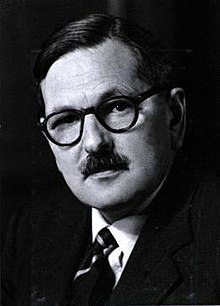Hugh Bamford Cott
| Hugh B. Cott | |
|---|---|

Hugh Bamford Cott, probably in 1945 when he became a fellow of Selwyn College. Courtesy of Selwyn College, Cambridge
|
|
| Born |
6 July 1900 Ashby Magna, Leicestershire |
| Died | 18 April 1987 (aged 86) Stoke Abbott, Dorset |
| Nationality | English |
| Alma mater | Selwyn College; University of Glasgow |
| Known for | Camouflage, Countershading |
| Spouse(s) | Joyce Radford |
| Children | Ruth |
| Scientific career | |
| Fields | Zoology |
| Institutions | Selwyn College |
| Thesis | The Problem of Adaptive Coloration with Special Reference to the Anura (1938) |
| Doctoral advisor | John Graham Kerr |
Hugh Bamford Cott (6 July 1900 – 18 April 1987) was a British zoologist, an authority on both natural and military camouflage, and a scientific illustrator and photographer. Many of his field studies took place in Africa, where he was especially interested in the Nile crocodile, the evolution of pattern and colour in animals. During the Second World War, Cott worked as a camouflage expert for the British Army and helped to influence War Office policy on camouflage. His book Adaptive Coloration in Animals (1940), popular among serving soldiers, was the major textbook on camouflage in zoology of the twentieth century. After the war, he became a Fellow of Selwyn College, Cambridge. As a Fellow of the Zoological Society of London, he undertook expeditions to Africa and the Amazon to collect specimens, mainly reptiles and amphibians.
Cott was born in Ashby Magna, Leicestershire, England, on 6 July 1900; his father was the rector there. He was schooled at Rugby. In 1919, he graduated from the Royal Military College, Sandhurst, and was commissioned into the Leicestershire Regiment. Between 1922 and 1925, he studied at Selwyn College, Cambridge.
He had intended to become a priest, and went to Cambridge to read theology, but after his first year he went on the university expedition to South America, where he studied natural forms in eastern Brazil in 1923, led by the entomologist Frank Balfour Browne, where he became fascinated by natural history, and changed his studies to zoology on his return. He then went on an expedition to the lower Amazon (1925–1926), and on research trips to the Zambesi river area in Africa (1927), including Mozambique, Zambia and East Africa, and Lanzarote (1930). He married Joyce Radford in 1928. He was a lecturer in Zoology at Bristol University from 1928 until 1932, when he moved to Glasgow University. He studied under another advocate of military camouflage, John Graham Kerr. His thesis, which he completed in 1935 under a Carnegie Fellowship, was on 'adaptive coloration' – both camouflage and warning coloration – in the Anura (frogs). In 1938 he was made a Doctor of Science at Glasgow, and he became a Zoology lecturer at Cambridge University and Strickland Curator of Birds at the university's Museum of Zoology.
...
Wikipedia
